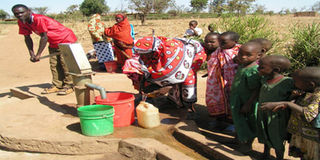Study: Diamond likely in Singida

A Singida resident pumps water from a well. If the dream comes true, Singida residents will benefit from diamond production. photo | file
What you need to know:
High Resolution Airbone Geophysical Data Survey Report released in Dar es Salaam on Friday confirms that the region would also be a hub for diamond mining in the country.
Dar es Salaam. Tanzania is set to yield more diamond after a new geological survey shows that Singida Region has the potential for such a mineral.
High Resolution Airbone Geophysical Data Survey Report released in Dar es Salaam on Friday confirms that the region would also be a hub for diamond mining in the country.
According to the chief executive officer (CEO) of the Geological Survey of Tanzania (GST), Prof Abdulkarim Mruma, the good news came after they identified the stockpiles of rocks that normally contain diamond.
“Singida has promising rocks for diamond. We have already taken a sample of the rocks and sent them to China for confirmation over diamond reserve in the region,” Prof Mruma noted during an interview with The Citizen.
The survey was conducted in 31 districts and established that most of the areas have the potential for certain types of minerals. Among others, the district involved in the survey include Babati,
Bagamoyo, Chamwino, Chunya, Gairo, Hanang, Handeni, Iramba, Kilindi, Kiteto, Kondoa, Manyoni, Mbozi, Mburu, Mpwapwa, Monduli, Moshi, Mvomero and Singida.
Most parts of the district showed also the potential for other minerals such as gold, copper and base metal. Launching the report, the minister for Energy and Minerals, Prof Sospeter Muhongo said the High Resolution Airbone Geophysical survey was a modern survey that the country had ever done.
Prof Muhongo said conventional geological surveys that were conducted in the past years were unable to precisely detect the potentiality of the minerals.
But, with the High Resolution Airbone Geophysical survey, the potential for minerals could be detected from a distance of 2 to 10 kilometres in deep sea.
He said the survey was a milestone for the country since after the confirmation of the minerals in those areas, small miners were going to benefit since the government had already set aside funds
for empowering this group in mining sites.
Prof Muhongo said from the colonial era up to now, the country had made notable progress in a geological survey. He said the survey was important as it gave new insight in the potential for minerals, also for identification of water sources, proper land use and environmental management.
He called on geological surveyors to distribute the report to investors and people living in those areas with the potential for minerals as well as for academic purposes.




